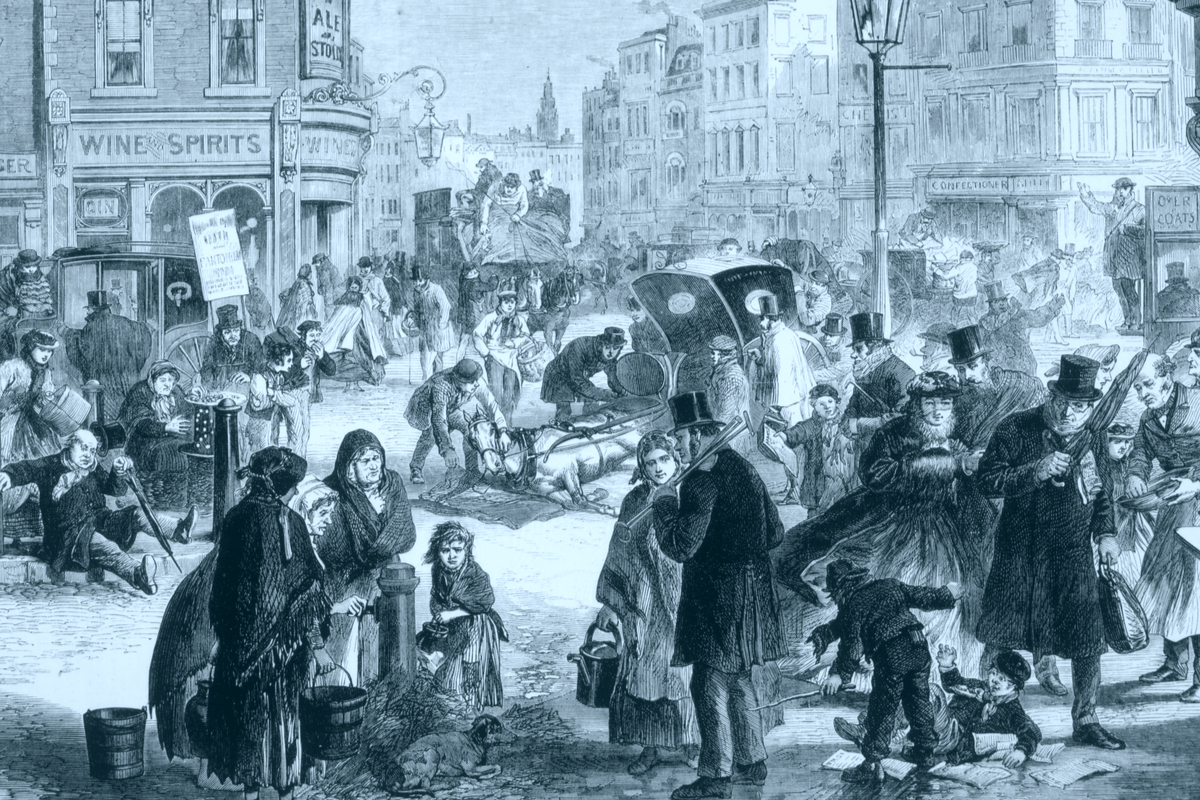 By Art Carden
By Art Carden
“Wouldn’t it have been nice to live in the past, when things were so much simpler? When we were rooted and connected? When we lived in harmony with one another, with nature, and with the generations that came before us?”
You’ve probably heard someone say that or something like it. Nostalgia for “the good old days” puzzles me because quite frankly, they were horrible by virtually any measure. The past is a fascinating place to visit — while reading or combing through historical records from the comfort of my well-lit, air-conditioned office or my well-lit, air-conditioned living room or a well-lit, air-conditioned coffee shop. I certainly wouldn’t want to live there.
Note my emphasis on “well-lit.” One of the products of the Enlightenment was a literal enlightenment. As 2018 economics co-Nobelist William Nordhaus explains, the cost of artificial lighting has been in freefall (my AIER colleague Peter C. Earle discusses Nordhaus’s work here). Light is so cheap that we remind ourselves and one another to turn the lights off when we leave rooms to conserve energy and protect the environment, not necessarily to save money. It’s an act that is increasingly liturgical and decreasingly financial. Contrast this to what Johnny Cash sang about in “Pickin’ Time”: “It’s hard to see by the coal oil light/and I turn it off pretty early at night/a jug of coal oil costs a dime/but I stay up late come pickin’ time.” Expensive coal oil and low incomes meant light was a luxury.
History is a story of literal and figurative darkness. Jonah Goldberg puts it this way on page 6 of his 2018 book Suicide of the West: “The natural state of mankind is grinding poverty punctuated by horrific violence terminating with an early death. It was like this for a very, very long time.”
Not so any longer. By virtually any measure, there has never been a better time to be alive. As Deirdre McCloskey argues in her “Bourgeois Era” trilogy and as she and I argue in this 2016 paper and this 2018 paper, things have never been so good.
Just how good are they? The late Hans Rosling — data virtuoso and TED talker extraordinaire — offered some of the important and relevant information in his 2018 book Factfulness (which was finished by his son and daughter after he passed away from pancreatic cancer). Rosling explains how important it is to get the facts straight. The facts about our liberalizing world are incredible.
First, people are a lot richer. In these videos, Deirdre McCloskey and Donald J. Boudreaux explain the “hockey stick” of rising per capita output around the world and what causes it:
The data give lie to the “rich get richer, poor get poorer” trope. In the last two decades, the global rate of extreme poverty has halved. Only 9 percent of the world’s population now lives in what are classified as “low income” countries, and 75 percent live in what are classified as “middle income” countries. By 2017, only 9 percent of the world’s population lived on less than $2 a day. That’s still nine percentage points too many, in my view, but it’s far better than the 85 percent of the world’s population living on less than $2 a day in 1800. To the extent that this was “a simpler time,” it was because grinding, $2-a-day poverty didn’t give people a lot of opportunities to make complex choices. If you didn’t scratch the ground hard enough day in and day out, you died. Simple as that.
Second, people live a lot longer. Worldwide, life expectancy in 1800 was 31. It had risen to 72 in 2017. People in poor countries today live longer than people in rich countries two centuries ago. Tumbling child mortality is one of the main reasons. In 1800, 44 percent of children died before age 5. In 2016, only 4 percent of a much larger population did. Perhaps there’s a simple, quiet dignity that comes with burying a child or dying in childbirth, but it’s a simple, serene dignity I and my wife are perfectly happy to live without.
Third, we’re a lot healthier and a lot safer. Rosling reports data on 194 countries. One hundred forty-eight of them had smallpox cases in 1850. None did in 1979. There were 453 disaster deaths per million in the 1930s and only 10 per million between 2010 and 2016 — which means that if climate change increases the disaster death rate tenfold, it will still be less than a quarter of what it was in the 1930s. In 1980, I was one of the 22 percent of one-year-olds who got at least one vaccination. In 2016, 88 percent of one-year-olds did.
Fourth, we have access to a dizzying array of cultural goods. In 1860, there was one new music recording. In 2015, there were 6,201,002. There was one new feature film in 1906 and 11,000 in 2016. In 1665, there were 119 scholarly articles published. In 2016, there were 2,550,000. An Oxford don in 1665 could have read literally all of the articles in scholarly journals. Today, it’s difficult to keep up with the articles in one’s very narrow subfield.
Importantly, what used to be limited to the literate and learned Oxford don is now more widely available to virtually anyone. In 1800, 10 percent of adults worldwide were literate. In 2016, it was 86 percent Liberal societies have democratized knowledge and brought us out of literal and figurative darkness and into literal and figurative light.
Importantly, music and movies and books and articles aren’t lost, so all these recordings and films and scholarly articles add to an existing stock of cultural capital. They don’t replace it. Of course, that means that garage bands and authors face ever-tougher challenges as they have to produce music that’s preferable, at the margin, to listening to Dark Side of the Moon again and books that are preferable, at the margin, to re-reading a classic or searching the classics for something you haven’t read yet.
Should we study and learn from the past? Of course we should. Should we yearn for the past, seek to return there, and perhaps undo the progress of the last several centuries? Of course we shouldn’t. We live longer, richer, healthier lives with opportunities to flourish that our ancestors couldn’t have comprehended. If anything, we should look upon our lot and sing for joy. With 11,000 playable guitars per million people in 2014 compared to only 200 per million people in 1962, I think we’re up to the challenge.
Here is a preview of Rosling’s Factfulness — again, the source for the numerical claims I make above, from pp. 50 and following — on Google Books:
Sign up here to be notified of new articles from Art Carden and AIER.
This article was sourced from AIER.org
Art Carden is a Senior Fellow at the American Institute for Economic Research. He is also an Associate Professor of Economics at Samford University in Birmingham, Alabama.
